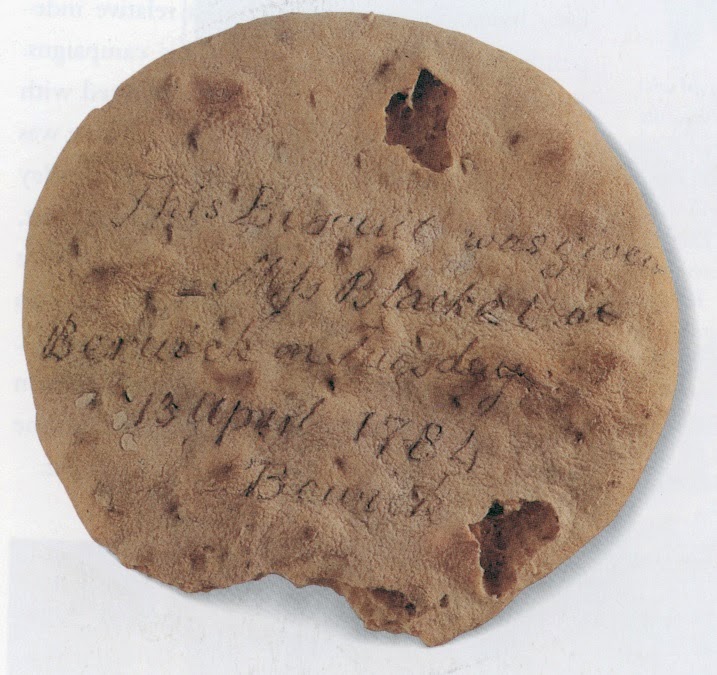William Falconer’s A New Universal Dictonary of Marine, ca. 1815 explains
victualling-office’s process of manufacturing sea biscuits:
BISCUIT, Sea, is a sort of bread much dried, to
make it keep for the use of the navy, and is good for a whole year after it is
baked.
The process of biscuit-making for the navy is
simple and ingenious, and is nearly as follows: A large lump of dough,
consisting merely of flower and water, is mixed up together, and placed exactly
in the centre of a raised platform, where a man sits upon a machine, called a
horse, and literally rides up and down throughout its whole circular direction,
till the dough is equally indented, and this is repeated till the dough is
sufficiently kneaded.
In this state it is handed over to a second
workman, who, with a large knife, puts it in a proper state for the use of
those bakers who more immediately attend the oven. They are five in number; and
their different departments are well calculated for expedition and exactness.
The first man on the farthest side of a large
table moulds the dough, till it has the appearance of muffins, and which he
does two together, with each hand; and then delivers them over to the man on
the other side of the table, who stamps them on both sides with
a mark, and throws them on a smaller table, where
stands the third workman, whose business is merely to separate the different
pieces into two, and place them under the hand of him who supplies the oven,
whose work of throwing or chucking the biscuits on the peel must be performed
with the greatest exactness and regularity. The fifth arranges them in the
oven, and is so expert, that though the different biscuits are thrown to him at
the rate of seventy in a minute, the peel is always disengaged in time to
receive them separately.
So much critical exactness and neat activity occur
in the exercise of this layout, that it is difficult to decide whether the palm
of excellence is due to the moulder, the maker, the splitter, the chucker, or
the depositor; all of them, like the wheels of a machine, seeming to be
actuated by the same principle. The business is to deposit in the oven seventy
biscuits in a minute; and this is accomplished with the regularity of a clock;
the clack of the peel, during its motion in the oven, operating like the
pendulum. The biscuits thus baked are kept in repositories, which receive
warmth from being placed in drying lofts over the ovens, till they are
sufficiently dry to be packed into bags, without danger of getting mouldy; and
when in such a state, they are then packed into bags,of an hundred weight each,
and removed into store-houses for immediate use.
At Deptford the bake house belonging to the
victualling-office has twelve ovens; each of which bakes twenty shoots daily;
the quantity of flour used for each shoot is two bushels, or 112 pounds; which
baked, produce 102 pounds of biscuit. Ten pounds are regularly allowed on each
shoot for shrinkage, &c. The allowance of biscuit in the navy is, one pound
for each man per day; so that, at Deptford alone, they can furnish bread,
daily, for 24,480 men, independent of Portsmouth and Plymouth.
The
ship’s biscuit above was given as a
souvenir to a Miss Blacket of Berwick in 1784 now in possession of the National
Maritime Museum - Greenwich.


